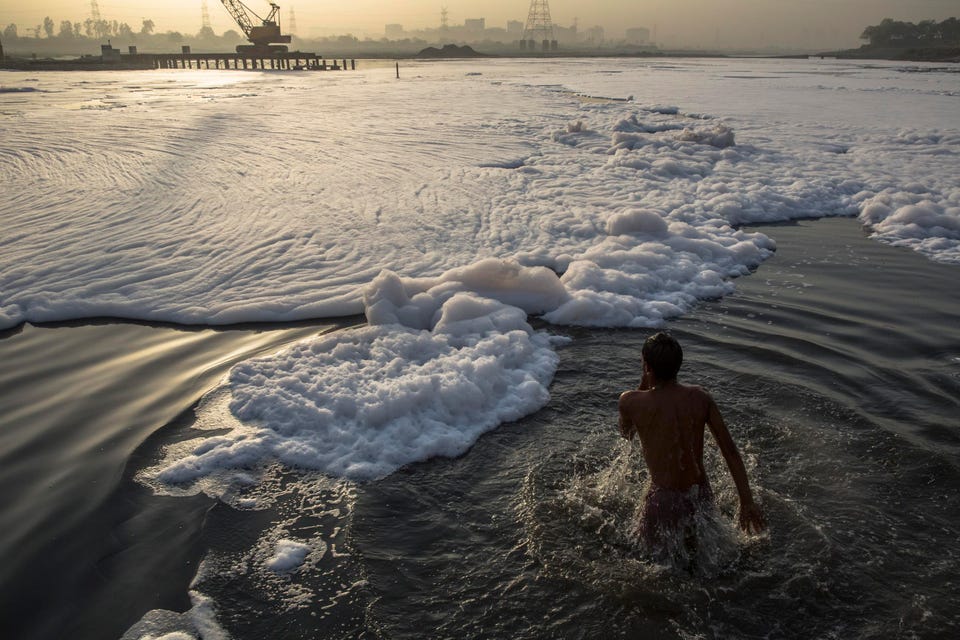Healthcare Pharmaceutical Pollution Impacts More Than 43% Of River Locations Globally Anuradha Varanasi Contributor Opinions expressed by Forbes Contributors are their own. Anuradha writes about environmental health disparities & epidemiology New! Follow this author to improve your content experience. Got it! Jun 24, 2022, 05:52am EDT | Share to Facebook Share to Twitter Share to Linkedin NEW DELHI, INDIA – MAY 24: An Indian man collects water as he bathes in an industrial waste-foam .
. . [+] polluted section of the Yamuna River, on the outskirts of New Delhi on May 24, 2013 in New Delhi, India.
The Yamuna river, holy to Hindus, traverses various urban centers like Delhi, Mathura, and Agra. These large urban centers draw fresh river water for various activities. In return, almost the entire waste water generated by these centers is disposed off into the river.
This is the prime reason for deterioration of Yamuna River water quality, according to the Central Pollution Control Board of India. (Photo by Daniel Berehulak/Getty Images) Getty Images A recent global assessment of the potential impacts of pharmaceutical ingredients on aquatic ecosystems found that approximately 43. 5% of the 1,056 river locations globally included in the study have high concentrations that could adversely impact marine animals and biodiversity.
The study, which was published in the journal Environmental Toxicology and Chemistry , assessed data from 258 rivers across 104 countries and delved into the concentrations of active pharmaceutical ingredients in surface waters. The researchers found that the most frequently detected pharmaceuticals were carbamazepine (an anticonvulsant), metformin (a Type 2 diabetes treatment), and caffeine. Alejandra Bouzas-Monroy at the University of York and colleagues further observed that the highest concentrations of pharmaceutical ingredients were in the surface waters of river sites in sub-Saharan Africa, South Asia, and South America.
Co-author John Wilkinson, who is also at the University of York, further noted that Lahore, Pakistan had the most polluted river system. The other molecules that were commonly found in multiple river locations were those used to treat depression, bacterial infections, epilepsy, anxiety, and hormonal that were present at concentrations that could have toxic impacts on marine ecosystems. While Africa had the highest proportion of polluted sites (27.
3%), North America had the lowest at 6. 8%. “These continental differences are likely explained by differences in the affordability and ease of access to certain medicines in regions with fewer regulations, differences in wastewater-treatment and waste-management infrastructure, and the presence of pharmaceutical manufacturing,” the researchers wrote in their paper.
MORE FOR YOU CDC: Salmonella Outbreak Has Left 279 Ill, 26 Hospitalized In 29 States Canadians End Up In ICU After Attending ‘Covid Party’ White House Mandates Pfizer Vaccines for Millions of Citizens . . .
Before the FDA Clinical or Safety Reviews Have Been Made Public Thanks to pharmaceutical ingredients and other forms of pollution like pesticides and fertilizers that are routinely released in rivers, algal blooms become a recurring problem. Schools of fish also get deeply impacted from exposure to active pharmaceutical ingredients — particularly antidepressants. This includes permanent changes in their brain chemistry and behavioral changes that make them more vulnerable to predators.
These pharmaceuticals also disrupt and impair reproduction in amphibians . But it is not just marine animals that suffer. In another study, scientists found that even at low levels in the environment, an antidepressant called fluoxetine resulted in starlings feeding less often than usual during their foraging routines that take place at sunrise and sunset.
“While the global monitoring study is probably the largest initiative of its kind to date, it still only provides a snapshot understanding of levels of exposure in a subset of the world’s rivers,” the researchers wrote. “In the future, we should build on Wilkinson’s work to extend environmental monitoring to a wider range of locations, sampling time points, and contaminant classes to gain a fuller picture of the impacts of the global pollution on the health of rivers across the world,” they added. Follow me on Twitter .
Anuradha Varanasi Editorial Standards Print Reprints & Permissions.
From: forbes
URL: https://www.forbes.com/sites/anuradhavaranasi/2022/06/24/pharmaceutical-pollution-impacts-more-than-43-of-river-locations-globally/
